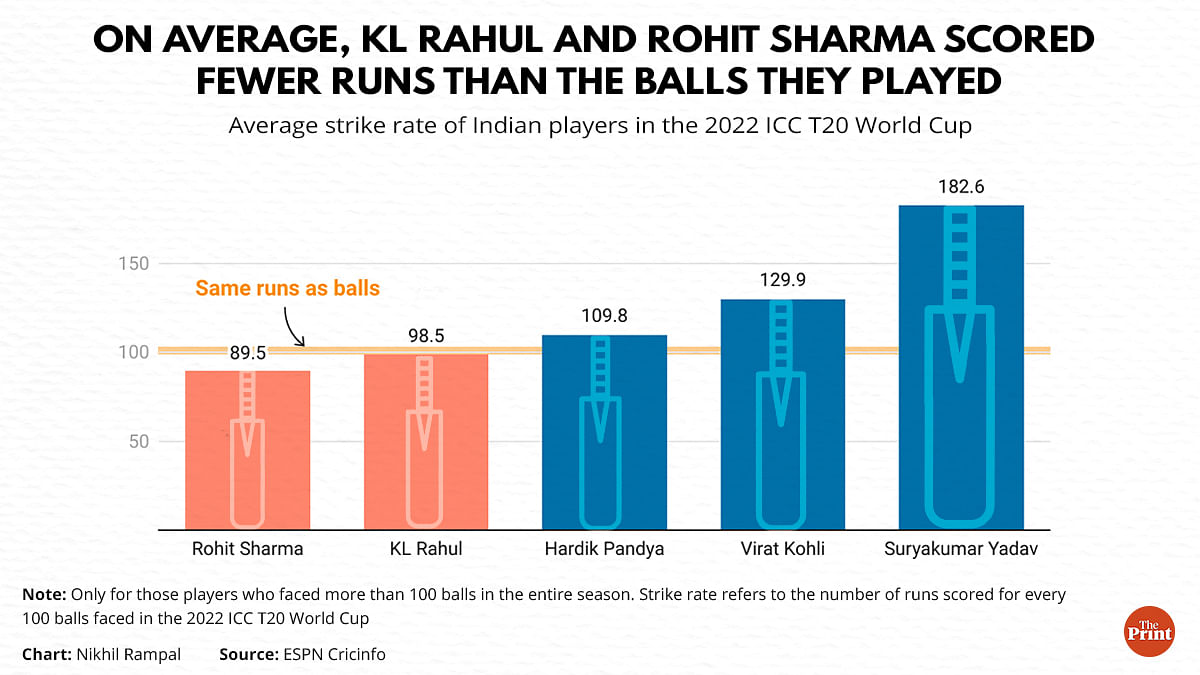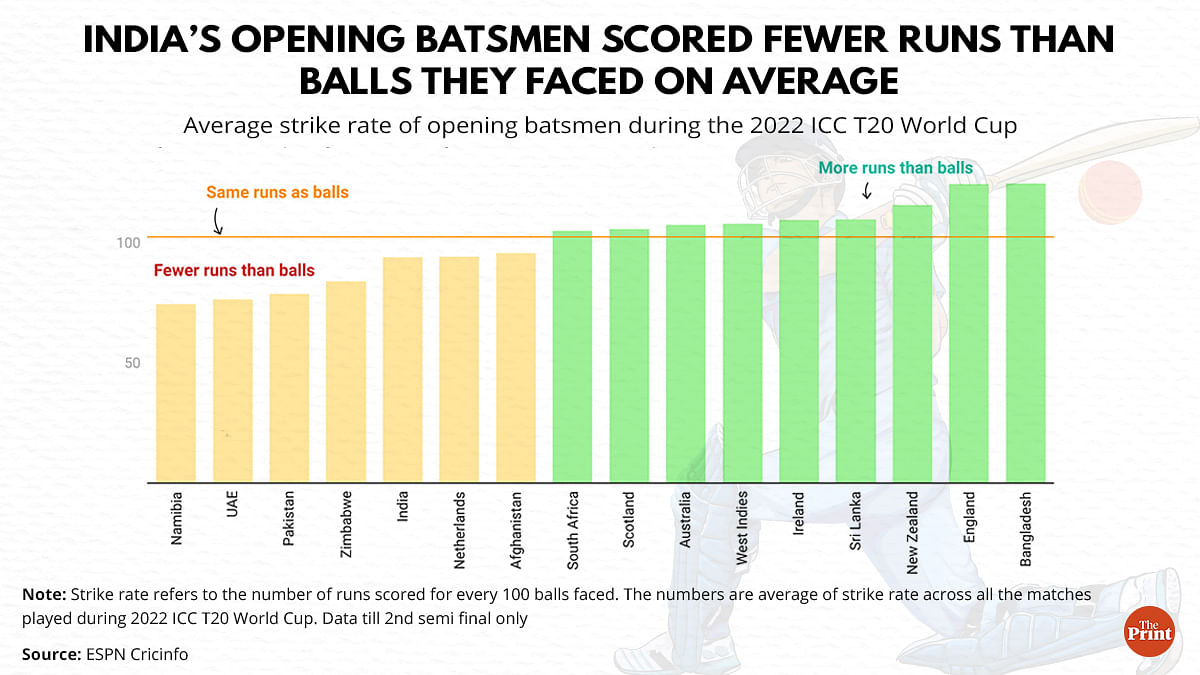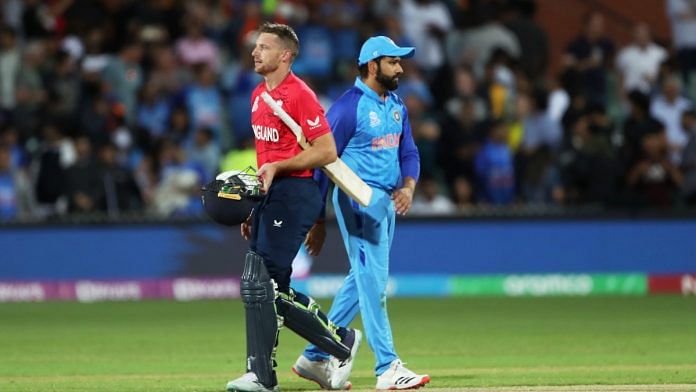New Delhi: After a crushing defeat against England in the semi-final of the ongoing 2022 T20 World Cup, India captain Rohit Sharma put the responsibility for the defeat on his bowlers.
“I thought we still batted pretty well at the back end to get to that score, but we were not good enough with the ball. It was definitely not a wicket where a team can come and chase it down in 16 overs. With the ball we didn’t turn up today,” he said Thursday, after England chased down the target of 169 runs without losing a single wicket.
But Rohit is being widely criticised by cricket fans for his statement even as India sorely missed its main strike bowler, Jasprit Bumrah, due to a back injury.
The ire against the skipper’s evaluation is not unfounded given that data shows an ebb and flow in India’s batting performance, especially of the openers.
Below par strike rate
Batting strike rate refers to the average number of runs a cricketer scores for every 100 balls he/she faces. There were only five batsmen who faced more than 100 balls in this T20 World Cup, with Rohit being the worst performer, data shows.

Rohit Sharma’s average strike rate was about 90 per 100 balls. What it essentially means is that he couldn’t average six runs per over in his first ICC (International Cricket Council) event as the skipper of Men in Blue.
His opening partner K. L. Rahul — who was trolled after Thursday’s loss — fared a shade better. Rahul’s average strike rate throughout the T20 World Cup was about 98.5, meaning that he, too, scored less than six runs per over.
Compared to the openers, the middle order comprising Hardik Pandya, Virat Kohli and Suryakumar Yadav took fewer balls to score more runs than them given their average strikes rate of 110, 130 and 182.6 respectively.
These averages are based on all the six teams (Pakistan, The Netherlands, South Africa, Bangladesh, Zimbabwe and England) India played against in the marquee tournament. And once their performance against the weaker teams — Zimbabwe, Bangladesh and The Netherlands — is subtracted, the strike rate of India’s batsmen also goes down.

Against weaker teams, K. L. Rahul scored more than seven runs per over. But when he faced England, Pakistan, and South Africa, the right-hand opener could barely score 4.2 runs per over on average. Rahul scored four runs in 8 balls against Pakistan, nine runs in 14 balls against South Africa and five runs in five balls against England.
Similarly, Rohit Sharma’s strike rate went down against strong teams. He averaged a strike rate of 92 against weak teams and 87 against big rivals.
With a strike rate of about 130, Virat Kohli showed his class as the former skipper notched four half-centuries in six matches.
Pandya’s strike rate against strong teams was higher (121) than against weak ones (91.6). But the fact that the all-rounder didn’t bat against the Netherlands has to be factored in.
Suryakumar Yadav lived up to expectations of being the best T20 batsman in the world. His strike rate against strong teams was 153 while it zoomed to 211 against weak teams. The swashbuckling batsman ended the campaign with three half-centuries.
Also Read: Play Pakistan, know Pakistan—why Indian cricket can’t afford to let go of the golden window
Weak start hit Team India bad

Unlike a 50–over match, cricket’s shortest format doesn’t give players the luxury of warming up in the initial overs; a weak start can prove to be detrimental in setting up challenging targets for opponents.
Rohit and Rahul were the fifth worst-performing pair among all the opening batsmen from the 16 countries that took part in the eighth edition of the ICC Men’s T20 World Cup tournament.
When you combine their average strike rate, India’s opening pair averaged 94 runs for every 100 balls bowled. This is better than only four other teams —Namibia (74.5), the UAE (76.4), Pakistan (78) and Zimbabwe (84.1).
In contrast, Bangladesh’s opening batsmen had the best average strike rate, mainly inflated due to Litton Das’ performance against India in which he plundered 60 runs off 27 balls.
On average, till the second semi-finals, opening batsmen scored a little over 100 runs per 100 balls. India’s opening pair performed below this level in the ongoing tournament.
Reacting to the team’s overall performance in the T20 World Cup, cricket commentator Harsha Bhogle said that India were playing “very conservative cricket”.
“India are still playing very conservative cricket. It was an issue they hoped to address and, in all fairness did, in bilateral cricket. But here at the World Cup, India were constantly hoping the back 10 overs would bail them out. Today, it wasn’t enough,” he tweeted.
Senior sports journalist Vikrant Gupta also pointed out after the England-India semi-final that T20 “doesn’t allow you the luxury of playing only risk-free cricket in the first 10-12 overs”.



